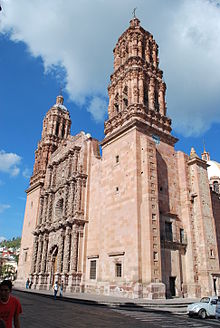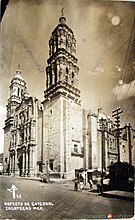
An altarpiece is an artwork such as a painting, sculpture or relief representing a religious subject made for placing at the back of or behind the altar of a Christian church. Though most commonly used for a single work of art such as a painting or sculpture, or a set of them, the word can also be used of the whole ensemble behind an altar, otherwise known as a reredos, including what is often an elaborate frame for the central image or images. Altarpieces were one of the most important products of Christian art especially from the late Middle Ages to the era of the Counter-Reformation.

The Metropolitan Cathedral of Morelia is a religious site that is the seat of the Archdiocese of Morelia of the Catholic church in Mexico. It is located as its name itself says in the city of Morelia, capital of the state of Michoacán, Mexico. The cathedral is located in the first square of the city, forming the trace of the Historic Center of Morelia. The building was built in the 18th century at the time of the viceroyalty, it is Baroque in style and is made of pink stone that gives it a peculiar and characteristic color. An important family group headed by Sebastián de Guedea collaborated in its construction for a long period; They were Andrés, Pedro, Diego, Miguel, Anastacio, Lorenzo and Joseph, all with the surname Guedea.
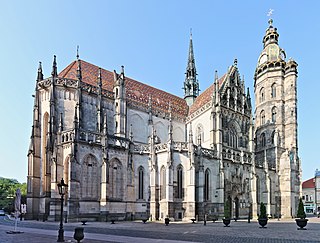
The Cathedral of St. Elizabeth, also called Saint Elizabeth Cathedral, is a Gothic cathedral in Košice, Slovakia. It is the largest church in Slovakia and one of the easternmost Gothic cathedrals in Europe.

The Cathedral of the Savior or La Seo de Zaragoza is a Roman Catholic cathedral in Zaragoza, in Aragon, Spain. It is part of the World Heritage Site Mudéjar Architecture of Aragon.

The Catedral de la Asunción de la Virgen, popularly known as New Cathedral is, together with the Old Cathedral, one of the two cathedrals of Salamanca, Castile and León, Spain. It is the seat of the diocese of Salamanca. It was constructed between 1533 and 1733 mixing late Gothic, Plateresque and Baroque styles. It was commissioned by Ferdinand V of Castile. It is one of the largest cathedrals in Spain in size and its bell tower, at 92 meters high, is also one of the tallest.

Assisi Cathedral, dedicated to San Rufino, is a major church in Assisi, Italy. This stately church in Umbrian Romanesque style was the third church built on the same site to contain the remains of bishop Rufinus of Assisi, martyred in the 3rd century. The construction was started in 1140 to the designs by Giovanni da Gubbio, as attested by the wall inscription visible inside the apse. He may be the same Giovanni who designed the rose-window on the façade of Santa Maria Maggiore in 1163.

The Metropolitan Cathedral of the Assumption of the Most Blessed Virgin Mary into Heaven is the cathedral church of the Roman Catholic Archdiocese of Mexico. It is situated on top of the former Aztec sacred precinct near the Templo Mayor on the northern side of the Plaza de la Constitución (Zócalo) in the historic center of Mexico City. The cathedral was built in sections from 1573 to 1813 around the original church that was constructed soon after the Spanish conquest of Tenochtitlan, eventually replacing it entirely. Spanish architect Claudio de Arciniega planned the construction, drawing inspiration from Gothic cathedrals in Spain.

The Basilica Cathedral of Puebla, as the Cathedral of Our Lady of the Immaculate Conception is known according to its Marian invocation, is the episcopal see of the Archdiocese of Puebla de los Ángeles (Mexico). It is one of the most important buildings in the historic center of Puebla declared a World Heritage Site by UNESCO. It has the prerogative of being the first sumptuous temple that under fine architectural designs was built in the Americas, consecrated in 1649, ahead of the Metropolitan of Mexico that was dedicated in 1653. It was founded by Philip II of Spain.
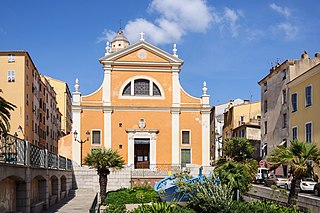
Ajaccio Cathedral, officially the Cathedral of Our Lady of the Assumption of Ajaccio and also known as the Cathedral of the Assumption of Saint Mary, is a Roman Catholic church located in Ajaccio, Corsica. The cathedral is the ecclesiastical seat of the Bishop of Ajaccio, a suffragan of the Archdiocese of Marseille. It is dedicated to the Virgin Mary, and is in the Baroque/Mannerist architectural style.

Santo Domingo in Mexico City refers to the Church of Santo Domingo and its Plaza, also called Santo Domingo. Both are located three blocks north of the Mexico City Metropolitan Cathedral following República de Brasil Street with Belisario Dominguez Street separating the two.
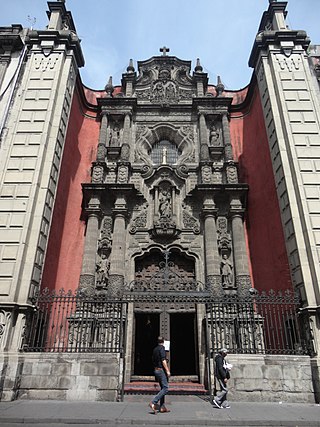
La Enseñanza Church (1772-1778) is located on 104 Donceles Street in the historic center of Mexico City. The Mexican Churrigueresque style of this church, especially that of its altarpieces, is upheld as the pinnacle of the Baroque period in Mexico, as this style soon gave way to the Neoclassic shortly after this church was built. The church’s official name is Iglesia de Nuestra Señora del Pilar. The former convent was called El Convento de la Enseñanza La Antigua, from which is derived the church’s popular name. After the Reform War, the convent was disbanded. The complex has had various uses, but the church has been returned to its sacred function.

The Cathedral of San Cristóbal de La Laguna or Catedral de Nuestra Señora de los Remedios is a Roman Catholic church in Tenerife, Spain. Begun in 1904 and completed in 1915, it is dedicated to the Virgin of Los Remedios. The cathedral is the mother church of the diocese, which includes the islands of Tenerife, La Palma, La Gomera and El Hierro in the province of Santa Cruz de Tenerife. It is therefore where the episcopal seat of the bishop of this diocese, currently occupied by Bishop Bernardo Álvarez Afonso. This is one of the most important churches of the Canary Islands.

The co-cathedral of Saint Eustace is the main church of Acquaviva delle Fonti. The dedication is to Saint Eustace. It is now a co-cathedral of the Diocese of Altamura-Gravina-Acquaviva delle Fonti. Previously it was the palatine church of Acquaviva delle Fonti, which became part of the territorial prelature of Altamura e Acquaviva delle Fonti formed by Pius IX in 1848, when he added Acquaviva to the existing territorial prelature of Altamura.

The Cathedral of Sigüenza, officially Catedral de Santa María de Sigüenza, is the seat of the bishop of Sigüenza, in the town of Sigüenza, in Castile-La Mancha, Spain. It was declared Bien de Interés Cultural in 1931.
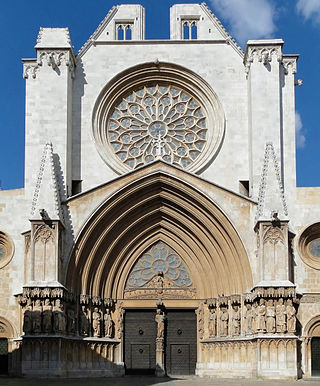
The Primatial Cathedral of Tarragona is a Roman Catholic church in Tarragona, Catalonia, Spain. The edifice is located in a site previously occupied by a Roman temple dating to the time of Tiberius, a Visigothic cathedral, and a Moorish mosque. It was declared a national monument in 1905.

The Co-Cathedral of Saint Nicholas in Prešov is one of the oldest and most important churches in Slovakia. The external dimensions of the cathedral are 54.7m in length, 34.45m in width. The indoor nave is 16 m tall and tower reaches a height of 71 meters. The temple's design takes inspiration from the Late Gothic hall churches with three naves.
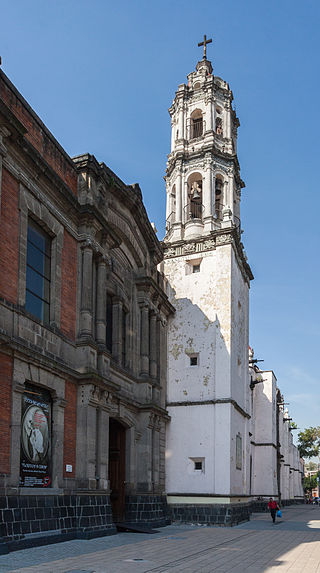
Regina Coeli Convent Church is a Roman Catholic parish church and former convent built in the historic center of Mexico City, on the corner of Regina and Bolivar Streets.

The monastery of San Martiño Pinario was a Benedictine monastery in the city of Santiago de Compostela, Galicia, Spain. It is the second largest monastery in Spain after San Lorenzo de El Escorial.

The Church of Nuestra Señora de la Asunción is a church and parish in Meco, Spain. The church was added to the Bien de Interés Cultural registry in 1982.

The Church and Convent of San Ignacio de Loyola de la Compañía de Jesús de Quito, also known in the Ecuadorian people simply as La Compañía, is a Catholic clerical complex located on the corner formed by calles García Moreno and Sucre, in the Historic Center of the city of Quito, capital of Ecuador. The façade of its main temple is entirely carved in volcanic stone. Over time, this church has also been called: "Temple of Solomon of South America". Father Bernardo Recio, a traveling Jesuit, called it "Golden Ember".
